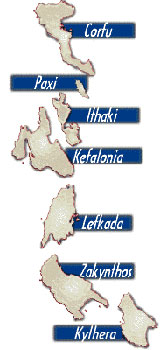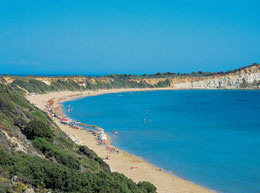Information about the Ionian Islands
of Greece
Corfu || Lefkada
|| Kefalonia || Zakynthos
|| Paxos || Ithaki || Kythera
 |
The only Greek island group not
in the Aegean, the Ionian islands lie just off the west coast
of Greece, in the Ionian Sea, at the entrance to the Adriatic.
They're believed to be the tips of a submerged mountain chain
that runs from the Adriatic to the Peloponnese.
There are seven main islands (the Greek name for the group
is Eptanissa, 'the seven islands'). Of these, six - Corfu, Paxos,
Ithaca, Lefkada, Kefallonia
and Zakynthos - are what
most people think of the Ionians. (The seventh, Kythira, is
to the south of the Peloponnese, so far apart from the others
that it doesn't feel part of the same group.)
All are lush, mountainous, green (they get lots of rain in winter)
and lovely. They look less typically Greek than other islands
- in fact they feel more Italian, with their slender cypress
trees and old Venetian buildings in shades of pink and ochre
- and they have a softer light than the brightness of the Aegean.
|
Everywhere there are deep green
pine forests, olive and citrus groves and vineyards, and the displays
of wildflowers- anemones, irises, daisies, orchids - are beautiful
in spring, especially in Corfu.
The islands largely escaped Ottoman occupation, but were instead
invaded by the Venetians and the British, both of whom left their
mark in a variety of ways, from architecture to cricket, sewers
to ginger beer.
There's not the same wealth of archaeological remains here that
you'll find elsewhere in Greece, but the mythological connections
are many. The Ionians are thought to get their name from the Greek
goddess Io, one of Zeus's paramours, who passed over here in flight
from his jealous wife Hera.
The island of Ithaca was famously home to Odysseus, he built his
ships on Kefallonia, and Corfu was his last stop on his long journey
home. The Odysseus connection is reflected in a large number of
bars, restaurants and streets named after him throughout the islands.
Tourism is well established here, especially on Corfu,
which was one of the first (and is still one of the most popular)
Greek islands to attract the British package holiday market.
Zakynthos, and to a lesser extent,
Kefallonia and Lefkada,
also have some large tourist developments, but there are plenty
of quieter pockets for those who don't want to join the party
crowds.
Best known, northernmost and greenest of the Ionians, Corfu (or
Kerkyra) is also considered by many to be possibly the most beautiful
of Greek islands. It has inspired many artists over the years:
Goethe, Oscar Wilde, Gerald and Lawrence Durrell, Alfred Sisley
and Edward Lear all painted or wrote about it.
|
|
It's certainly the most developed island,
and is hugely popular with the British: half a million of us flock
there every summer. However, 80 per cent stick to 20 per cent
of the coastline, so you can always find somewhere quiet. It has
an attractive, cosmopolitan capital city in Corfu
Town, and over 100 miles of coastline, with dramatic cliffs
and beaches (both pebbly and sandy), and famously lovely bays
and grottoes near Paleokastritsa.
Inland, there's plenty to attract walkers, ornithologists and
botanists - in spring the wildflower displays are particularly
impressive.
Also renowned for its beauty is Zakynthos (or Zante), most southerly
of the Ionians. The Venetians called it "the flower of the
Orient". Almost triangular in shape, the island has two green
mountainous promontories extending into the sea to form the huge
bay of Laganas, an area that's been rather overdeveloped by tourism.
The main town (Zakynthos Town) was destroyed by an earthquake
in 1953 and since rebuilt - so there's not much to see there. |
 |
However, the countryside is pretty,
with pine-covered mountains and hills in the north, a gentle,
lush centre (where currant vines, olive trees, almonds and vegetables
are grown), and dozens of sandy beaches. Zakynthos is also famous
for its caves and excellent diving opportunities.
Largest of the Ionian Islands and (prior to the success of Louis
de Bernières' best-selling novel Captain Corelli's Mandolin,
at any rate) the least developed, Kefallonia has dramatic scenery,
wonderful beaches and strong traditions. |
The pretty fishing harbour of Fiskardo in
the north, with its Italianate houses, is a busy summer resort
and there are picturesque Venetian fortresses at Kastro and Assos
(the latter with great views down over the bay of Myrtos, renowned
for its afternoon sun and soft white sand). There are wonderful
views, too, from Mount Enos, 5,340ft/1,628metres above sea level,
looking out over the island and its neighbours.
The island is known for its wine, olives and olive oil, and, like
Zakynthos, famous for its caves. On the northwest coast it's possible
to spot monk seals, rarest of the seal species and highly endangered,
mainly because of habitat disruption caused by the tourist trade.
Across a narrow strait to the east of Kefallonia lies Ithaca (or
Ithaki), famously home of Odysseus. Small, sleepy and peaceful,
it has no airport, no big modern hotels (the lack of great beaches
means it's not very touristy, and visitors should book ahead if
they intend to stay), and no swimming pools (water's in short
supply). However, it has lovely scenery and is the most mountainous
of the islands. |
The capital of Ithaki (or Vathi)
lies at the end of a deep fjord-like bay, with a spectacular harbour
approach. Homer fans can explore a number of Odyssey sights, including
the Cave of the Nymphs, where it's said that Odysseus hid the
gifts bestowed upon him by King Alcinous when he finally returned
home long after the end of the Trojan War.
Tiny but perfectly formed, Paxos (or Paxi) is the smallest of
the major Ionians and one of the smallest of all Greek islands.
Very simple and undeveloped, it's the place to come if you want
a really quiet holiday. |
|
At the same time, it's upmarket and expensive,
with a roster of celebrity regulars. Thick with grapevines and
olive trees (it's a good place to pick up olive oil).
Paxos has wonderful beaches and translucent waters, and the gorgeous
west coast is lined with spectacular cliffs and grottoes accessible
only by boat. The villages of Gaios (the capital), Lakka and Longos
are all picturesque and charming. The neighbouring tiny island
of Antipaxos (Antipaxi) is a quick boat-ride away - go for the
beaches and a wander through its renowned vineyards.
Barely an island at all (it's linked to the mainland by a causeway
at the north), Lefkada is green, fertile and deeply traditional
at heart - in the inland villages you'll still see old women sitting
on doorsteps making lace and old men hanging out at the kafeinion.
The island is busy with Greek and Italian holiday-makers in mid-summer,
and popular with windsurfers who come on pilgrimage to Vassiliki.
It has a picturesque capital in the form of Lefkada/Lefkas Town,
with its distinctive multicoloured wooden houses, and a popular
holiday spot in Nidri, on the east coast.
From Lefkada, it's easy to drive to the attractions of Epirus
on the mainland, and off the southeast coast is the small island
of Meganisi with its beautiful beaches.
Isolated from the rest of the Ionians, round the corner of the
Peloponnese, Kythira looks different
to the other islands (more like the Cyclades, in fact) although
it shares historical rule from Venice and Britain with the rest
of the Ionians. |
© Corfutoday.com -
Travel and Holiday Guide
All Rights Reserved. No part of this web site may be reproduced
without permission.
|
|
|

